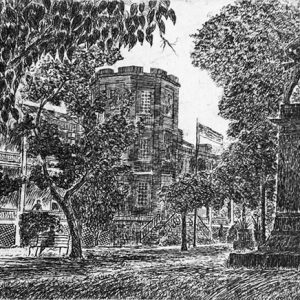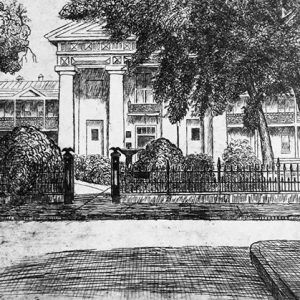calsfoundation@cals.org
James Carl Hancock (1898–1966)
James Carl Hancock was a twentieth-century American etcher, designer, painter, and commercial artist active in Arkansas and Louisiana. His art depicted many landscapes and historic buildings in and around Little Rock (Pulaski County). The Smithsonian American Art Museum in Washington DC holds Hancock’s engraving St. Andrew’s Cathedral, Little Rock, Arkansas, a mezzotint on paper produced around 1935.
Carl Hancock was born on May 10, 1898, in Springville, Tennessee, the oldest of ten children of Ernest Maralle (Ernie) and Myrtle Blanche Nash Hancock. The family moved to Arkansas in 1901, first settling in Stuttgart (Arkansas County) and later moving to Brinkley (Monroe County), where Hancock completed school through the seventh grade. He moved to the Little Rock area in 1917 and for many years lived in North Little Rock (Pulaski County).
Hancock’s artistic talents were evident at an early age. He had little formal art training and learned through reading and studying art books found in local libraries. Hancock was influenced and encouraged by artist A. P. Finken.
When Hancock first began to experiment with etching, he scavenged copper from local junkyards. After straightening, cleaning, and smoothing the surfaces, Hancock could draw on the plates. As his skills progressed, Hancock designed an etching press from an illustration, and a machinist friend constructed the press from discarded parts.
Hancock married Lela Perry, a Little Rock school teacher, on December 21, 1933; they had no children. The couple spent each summer in New Orleans, Louisiana. Hancock loved the beauty of New Orleans and produced many drawings, etchings, and watercolors of the French Quarter, including the St. Louis Cathedral, Court of Two Sisters, Antoine’s, Iron Lace Work, and the award-winning etching Pirates Alley.
Hancock identified and hand-signed his works and sold them as prints, postcards, matchbook covers, bridge tallies, note cards, and souvenir booklets. In 1938, Hancock published the booklet New Orleans Etchings, Drypoints and Sketches, which became popular in the city. Hancock also produced keepsake booklets for Natchez, Mississippi; Memphis, Tennessee; and Little Rock.
Hancock selected subjects throughout the South. During his travels, he often sketched with pen and ink and later transferred the drawings to highly polished copper plates. Back in Arkansas, Hancock created many etchings, including the Old State House, MacArthur Park, The Territorial Capitol (now called Historic Arkansas Museum), The Old Mill, and Plantation Road. These pieces are among his best-known works.
Hancock was a member of the Southern States Art League, the Southern Printmakers Society, and the Mississippi Art Association. He was listed in Who’s Who in American Art (1947 and 1959), Who Was Who in American Art, 1564–1975, and Who Is Who in Arkansas.
Hancock’s art is included in the permanent collections of the Smithsonian Institution, the Ogden Museum of Southern Art, the University of New Orleans, Louisiana State University, Historic Arkansas Museum, and many other museums and private collections.
In 2008–09, Historic Arkansas Museum exhibited The Art of Carl Hancock, which featured approximately twenty-two sketches and etchings from the museum’s permanent collection and the collection of Hancock’s niece, Myrtie Engelkes.
Hancock died on June 19, 1966, and is buried in Oakland Cemetery in Little Rock.
For additional information:
Allard, B. Who Is Who in Arkansas. 1st ed., Vol. 1. Little Rock, AR: Allard House Publishing, 1959.
Carl Hancock Art Collection. Butler Center for Arkansas Studies. Central Arkansas Library System, Little Rock, Arkansas. Finding aid online at https://cdm15728.contentdm.oclc.org/digital/collection/findingaids/id/5292/rec/1 (accessed February 28, 2025).
Deane, Ernie. “An Arkansas Artist Follows an Ancient Craft.” Arkansas Gazette, September 29, 1963, p. 5E.
Williams, Lynn Barstis. Imprinting the South: Southern Printmakers and Their Images of the Region, 1920s–1940s. Tuscaloosa: University of Alabama Press, 2007.
Thomas A. Teeter
Little Rock, Arkansas

 MacArthur Park Etching
MacArthur Park Etching  Old State House Etching
Old State House Etching 



Comments
No comments on this entry yet.